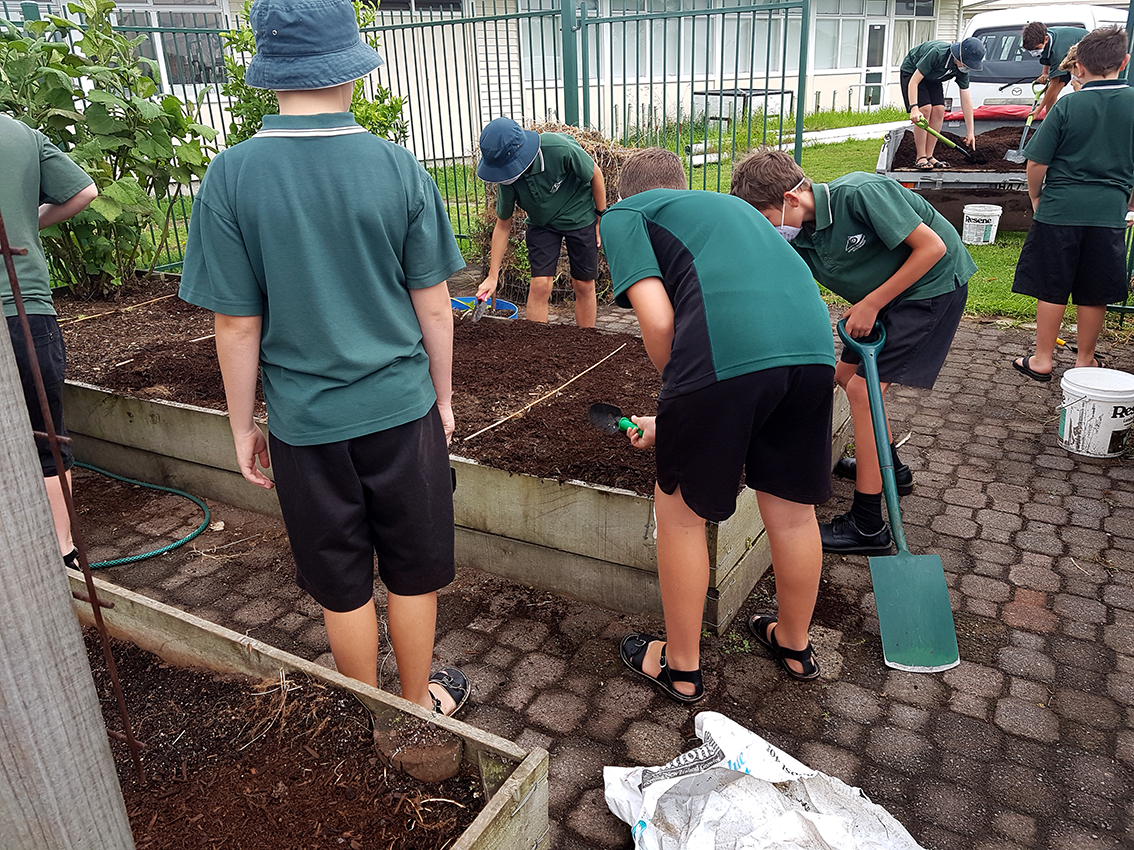
Mount Maunganui Intermediate School’s Blog
The Story of Jacob and Jack’s Garden
Beside the caretaker’s office was a strip of empty land. It was sheltered, it was sunny, it was a great place to grow things, but all it was growing was grass. Clare and Mrs Taylor thought it would be a good spot to make a garden for Jacob and Jack, two of our most dedicated gardeners who come out every lunchtime to work in the gardens.
Jacob and Jack were keen to have their very own space, but before they started digging they had to think hard about what they needed do to make the garden work. They realised the soil here very is sandy and nothing would grow well in it if they left it the way it was. So they added some compost. Clare also mentioned that making a clay slurry would help to bind the sand – Clare will get some clay in a few weeks when it’s properly autumn and there’s more moisture in the ground and they will add it in then.
Jacob and Jack discussed with Clare which would be suitable plants to put into the garden at this time of the year, and talked about how wind, sun and rain will affect the different plants.
Finally, once all the planning and preparation was done, the carefully chosen seedlings were planted, with a protective layer of pea straw mulch added around them.
Watch this space to follow the progress of this brand new garden!
The grass dug up, edging added, and the compost going in.
Seedlings being planted and mulch being added.
A New Way of Planting
Kevin is from Korea and it was his first day at garden club. He chose a plot and then started working it, weeding and turning the soil. Then to our surprise he made these trenches in the soil and mounded four rows up.
We were fascinated as it was totally different from how we are accustomed to doing things here. Kevin said it was the Korean way – you plant on the top of the mound, and the lower trenches hold the water. We can’t wait to see how well his plants grow. Maybe we can try doing this with some of our other plants too, and compare what does better.
Today Clare also talked about mulching and why we do it. She showed us a diagram that explained how 80% of the water we put onto the soil will evaporate unless we use mulch. If mulch is added the figure goes right down to 10%. That tells us mulching is definitely a good idea!
We talked about different mulches – dead leaves, newspaper, comfrey, seaweed and pea straw – and the pros and cons of each.
Clare had some of each of them that we could use but we all chose pea straw. Why? We’ll let you know in another post soon.
Coming Up Roses
Hannah and Amber looove roses, so they volunteered to take care of the school rose garden. They’ve been doing a great job and have been doing lots of reading about how to look after them and researching which varieties we have growing here. They’ve been giving the plants lots of water, worm wee and some special mulch that Clare was given. After Easter Clare is going to teach us all how to make natural sprays to help protect them from pests, and we’ll also start doing some companion planting which will help them even more.
Staying on the subject of roses, it’s becoming a ritual for the Block 2 kids to make rose petal tea to drink at discussion time. We’ve been experimenting with different petals and deciding whether we need to add sugar.
And speaking of adding a little sugar… Hannah and Amber decided that the teachers needed some cheering up – what better way than with these lovely blooms :)
Welcome!
Welcome to Mount Intermediate’s Garden Club. Clare, our garden facilitator, and Mrs Taylor are going to help us grow, learn and explore this year, and maybe we’ll get to cook with some of what we grow too. Our students are running in two groups we call Block 1 and Block 2, which means we have lots of willing workers and will be able to get plenty done.
Today the Block 1 students started the day by putting compost on all the beds that we’d worked hard to clear out during the week. Clare gave us a talk about wearing masks and gloves when handling compost and potting mix. Clare and Mrs Taylor were amazed at how quickly we worked.
After spreading the compost it started to rain, so we went indoors and watched a video about how seeds germinate. We learned that the roots sprout first and get nourishment from the soil, which gives the plant the strength to put up a shoot, then the leaves appear and start growing.
Clare gave us a plastic cup, handy towels and four dried peas. We wet the paper towels so they were damp, put them into the cups and placed the peas into the damp towels. We need to water the cup every day and see what happens. Watch this space!
Mrs Taylor had bought some seedlings and thanks to the hard work of the Block 1 students spreading all the compost, Block 2 were able to start planting into the garden beds. It’s a big change for a tiny seedling to be uprooted from its tray and put into a whole new environment, with different soil, different temperatures and different surroundings, and sometimes they find it hard to recover and don’t grow strongly. This is known as ‘transplant shock’. However there are things we can do to help the plant at this time. Clare talked to us about dipping the roots of our seedlings into seaweed fertiliser before we put them into the ground. Giving them some instant nourishment like this means the roots won’t get as stressed while they settle into their new home.










